HLTAAP002 Case Study: Gastro-Oesophageal Reflux Disease (GORD)
VerifiedAdded on 2023/01/07
|6
|1480
|77
Case Study
AI Summary
This case study examines Gastro-Oesophageal Reflux Disease (GORD), presenting a detailed analysis of its pathophysiology, clinical manifestations, and management strategies. The assignment addresses key aspects of the disease, including the underlying mechanisms of GORD, common symptoms such as regurgitation and heartburn, and appropriate referrals for related issues like tooth decay. It also explores the action, indications, and contraindications of Omeprazole, a common medication used in GORD treatment. Furthermore, the case study identifies health professionals suitable for managing GORD, such as surgeons and medical professionals focusing on lifestyle modifications like reducing alcohol consumption. The study incorporates relevant references, offering a comprehensive overview of GORD and its clinical management.
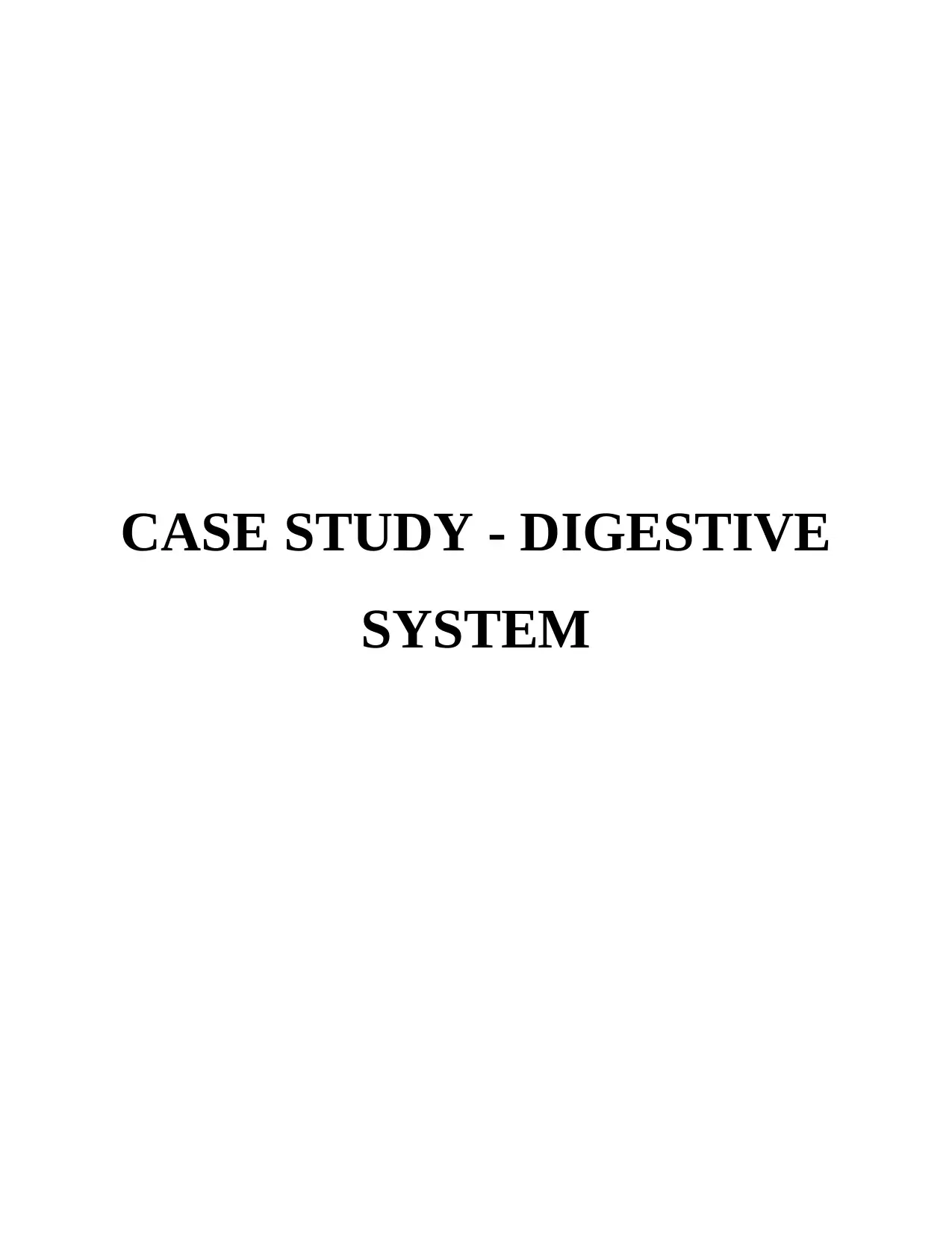
CASE STUDY - DIGESTIVE
SYSTEM
SYSTEM
Paraphrase This Document
Need a fresh take? Get an instant paraphrase of this document with our AI Paraphraser
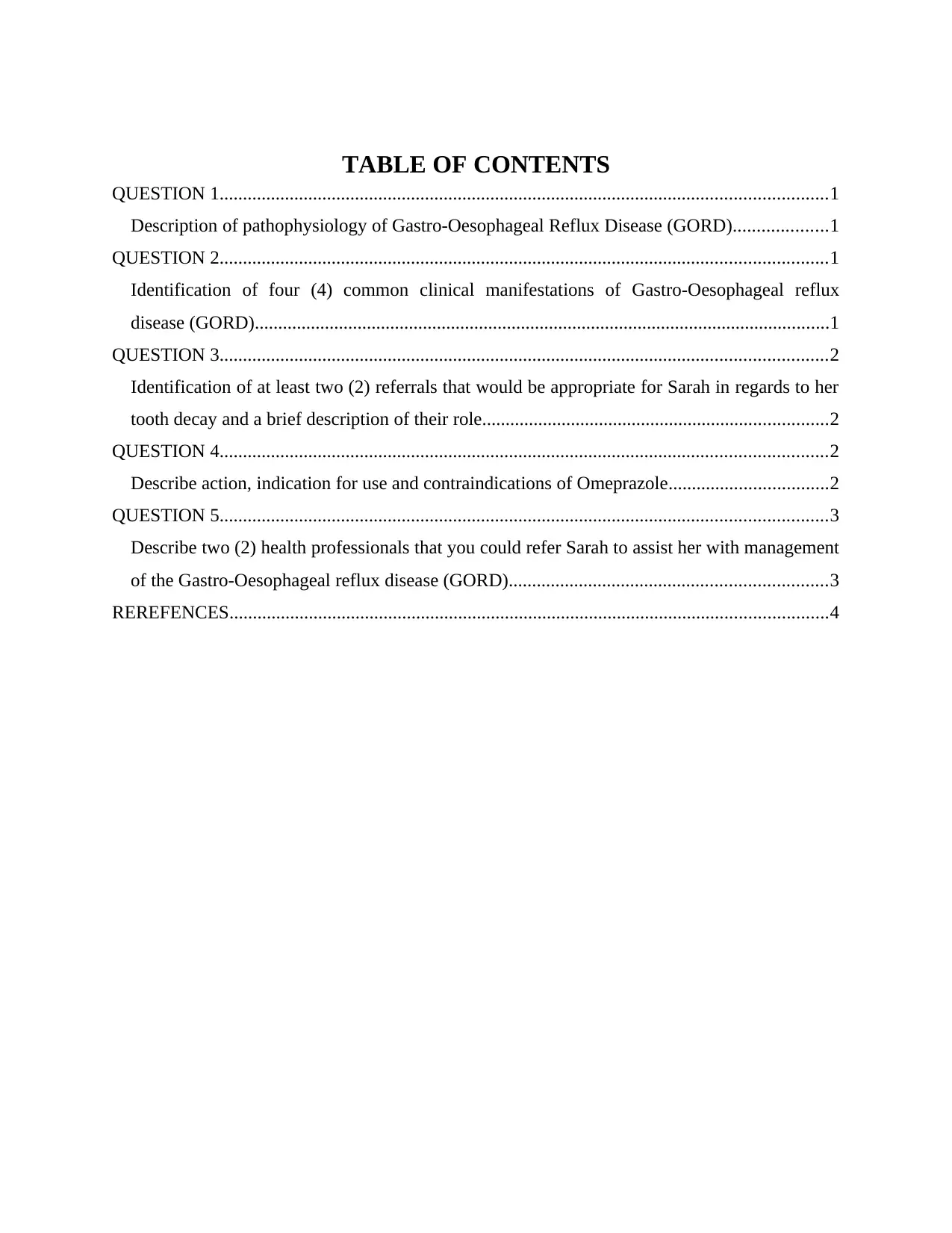
TABLE OF CONTENTS
QUESTION 1..................................................................................................................................1
Description of pathophysiology of Gastro-Oesophageal Reflux Disease (GORD)....................1
QUESTION 2..................................................................................................................................1
Identification of four (4) common clinical manifestations of Gastro-Oesophageal reflux
disease (GORD)...........................................................................................................................1
QUESTION 3..................................................................................................................................2
Identification of at least two (2) referrals that would be appropriate for Sarah in regards to her
tooth decay and a brief description of their role..........................................................................2
QUESTION 4..................................................................................................................................2
Describe action, indication for use and contraindications of Omeprazole..................................2
QUESTION 5..................................................................................................................................3
Describe two (2) health professionals that you could refer Sarah to assist her with management
of the Gastro-Oesophageal reflux disease (GORD)....................................................................3
REREFENCES................................................................................................................................4
QUESTION 1..................................................................................................................................1
Description of pathophysiology of Gastro-Oesophageal Reflux Disease (GORD)....................1
QUESTION 2..................................................................................................................................1
Identification of four (4) common clinical manifestations of Gastro-Oesophageal reflux
disease (GORD)...........................................................................................................................1
QUESTION 3..................................................................................................................................2
Identification of at least two (2) referrals that would be appropriate for Sarah in regards to her
tooth decay and a brief description of their role..........................................................................2
QUESTION 4..................................................................................................................................2
Describe action, indication for use and contraindications of Omeprazole..................................2
QUESTION 5..................................................................................................................................3
Describe two (2) health professionals that you could refer Sarah to assist her with management
of the Gastro-Oesophageal reflux disease (GORD)....................................................................3
REREFENCES................................................................................................................................4
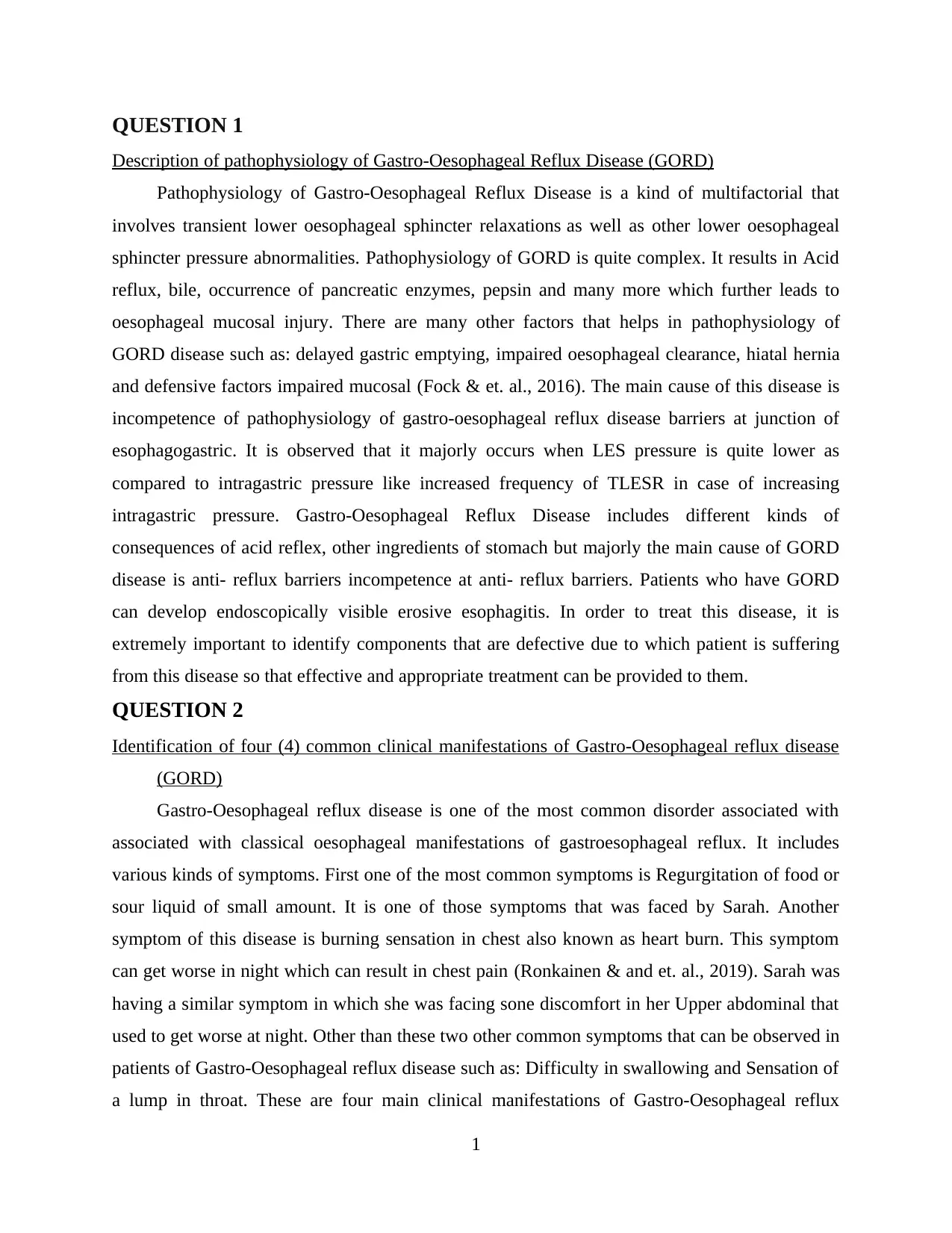
QUESTION 1
Description of pathophysiology of Gastro-Oesophageal Reflux Disease (GORD)
Pathophysiology of Gastro-Oesophageal Reflux Disease is a kind of multifactorial that
involves transient lower oesophageal sphincter relaxations as well as other lower oesophageal
sphincter pressure abnormalities. Pathophysiology of GORD is quite complex. It results in Acid
reflux, bile, occurrence of pancreatic enzymes, pepsin and many more which further leads to
oesophageal mucosal injury. There are many other factors that helps in pathophysiology of
GORD disease such as: delayed gastric emptying, impaired oesophageal clearance, hiatal hernia
and defensive factors impaired mucosal (Fock & et. al., 2016). The main cause of this disease is
incompetence of pathophysiology of gastro-oesophageal reflux disease barriers at junction of
esophagogastric. It is observed that it majorly occurs when LES pressure is quite lower as
compared to intragastric pressure like increased frequency of TLESR in case of increasing
intragastric pressure. Gastro-Oesophageal Reflux Disease includes different kinds of
consequences of acid reflex, other ingredients of stomach but majorly the main cause of GORD
disease is anti- reflux barriers incompetence at anti- reflux barriers. Patients who have GORD
can develop endoscopically visible erosive esophagitis. In order to treat this disease, it is
extremely important to identify components that are defective due to which patient is suffering
from this disease so that effective and appropriate treatment can be provided to them.
QUESTION 2
Identification of four (4) common clinical manifestations of Gastro-Oesophageal reflux disease
(GORD)
Gastro-Oesophageal reflux disease is one of the most common disorder associated with
associated with classical oesophageal manifestations of gastroesophageal reflux. It includes
various kinds of symptoms. First one of the most common symptoms is Regurgitation of food or
sour liquid of small amount. It is one of those symptoms that was faced by Sarah. Another
symptom of this disease is burning sensation in chest also known as heart burn. This symptom
can get worse in night which can result in chest pain (Ronkainen & and et. al., 2019). Sarah was
having a similar symptom in which she was facing sone discomfort in her Upper abdominal that
used to get worse at night. Other than these two other common symptoms that can be observed in
patients of Gastro-Oesophageal reflux disease such as: Difficulty in swallowing and Sensation of
a lump in throat. These are four main clinical manifestations of Gastro-Oesophageal reflux
1
Description of pathophysiology of Gastro-Oesophageal Reflux Disease (GORD)
Pathophysiology of Gastro-Oesophageal Reflux Disease is a kind of multifactorial that
involves transient lower oesophageal sphincter relaxations as well as other lower oesophageal
sphincter pressure abnormalities. Pathophysiology of GORD is quite complex. It results in Acid
reflux, bile, occurrence of pancreatic enzymes, pepsin and many more which further leads to
oesophageal mucosal injury. There are many other factors that helps in pathophysiology of
GORD disease such as: delayed gastric emptying, impaired oesophageal clearance, hiatal hernia
and defensive factors impaired mucosal (Fock & et. al., 2016). The main cause of this disease is
incompetence of pathophysiology of gastro-oesophageal reflux disease barriers at junction of
esophagogastric. It is observed that it majorly occurs when LES pressure is quite lower as
compared to intragastric pressure like increased frequency of TLESR in case of increasing
intragastric pressure. Gastro-Oesophageal Reflux Disease includes different kinds of
consequences of acid reflex, other ingredients of stomach but majorly the main cause of GORD
disease is anti- reflux barriers incompetence at anti- reflux barriers. Patients who have GORD
can develop endoscopically visible erosive esophagitis. In order to treat this disease, it is
extremely important to identify components that are defective due to which patient is suffering
from this disease so that effective and appropriate treatment can be provided to them.
QUESTION 2
Identification of four (4) common clinical manifestations of Gastro-Oesophageal reflux disease
(GORD)
Gastro-Oesophageal reflux disease is one of the most common disorder associated with
associated with classical oesophageal manifestations of gastroesophageal reflux. It includes
various kinds of symptoms. First one of the most common symptoms is Regurgitation of food or
sour liquid of small amount. It is one of those symptoms that was faced by Sarah. Another
symptom of this disease is burning sensation in chest also known as heart burn. This symptom
can get worse in night which can result in chest pain (Ronkainen & and et. al., 2019). Sarah was
having a similar symptom in which she was facing sone discomfort in her Upper abdominal that
used to get worse at night. Other than these two other common symptoms that can be observed in
patients of Gastro-Oesophageal reflux disease such as: Difficulty in swallowing and Sensation of
a lump in throat. These are four main clinical manifestations of Gastro-Oesophageal reflux
1
⊘ This is a preview!⊘
Do you want full access?
Subscribe today to unlock all pages.

Trusted by 1+ million students worldwide
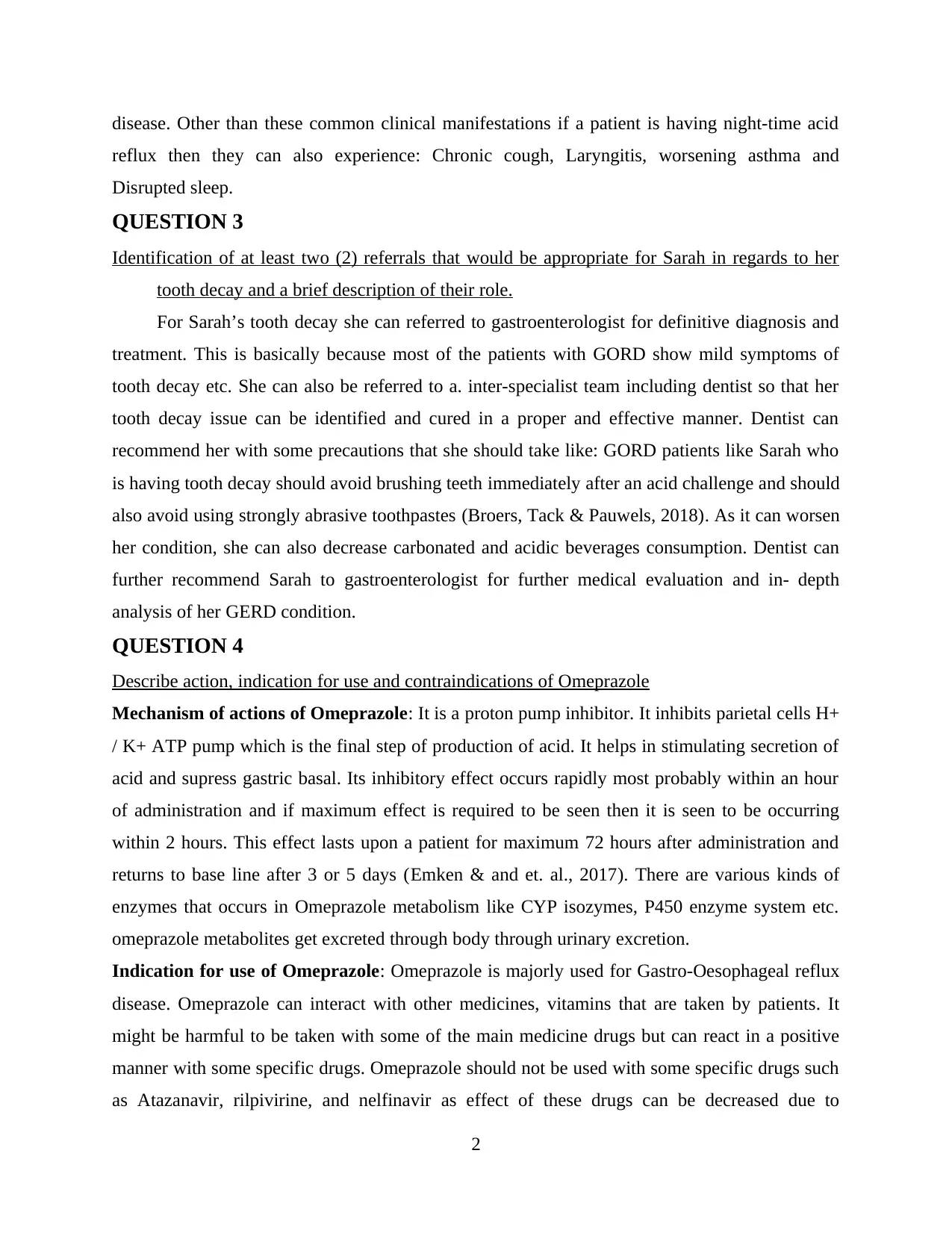
disease. Other than these common clinical manifestations if a patient is having night-time acid
reflux then they can also experience: Chronic cough, Laryngitis, worsening asthma and
Disrupted sleep.
QUESTION 3
Identification of at least two (2) referrals that would be appropriate for Sarah in regards to her
tooth decay and a brief description of their role.
For Sarah’s tooth decay she can referred to gastroenterologist for definitive diagnosis and
treatment. This is basically because most of the patients with GORD show mild symptoms of
tooth decay etc. She can also be referred to a. inter-specialist team including dentist so that her
tooth decay issue can be identified and cured in a proper and effective manner. Dentist can
recommend her with some precautions that she should take like: GORD patients like Sarah who
is having tooth decay should avoid brushing teeth immediately after an acid challenge and should
also avoid using strongly abrasive toothpastes (Broers, Tack & Pauwels, 2018). As it can worsen
her condition, she can also decrease carbonated and acidic beverages consumption. Dentist can
further recommend Sarah to gastroenterologist for further medical evaluation and in- depth
analysis of her GERD condition.
QUESTION 4
Describe action, indication for use and contraindications of Omeprazole
Mechanism of actions of Omeprazole: It is a proton pump inhibitor. It inhibits parietal cells H+
/ K+ ATP pump which is the final step of production of acid. It helps in stimulating secretion of
acid and supress gastric basal. Its inhibitory effect occurs rapidly most probably within an hour
of administration and if maximum effect is required to be seen then it is seen to be occurring
within 2 hours. This effect lasts upon a patient for maximum 72 hours after administration and
returns to base line after 3 or 5 days (Emken & and et. al., 2017). There are various kinds of
enzymes that occurs in Omeprazole metabolism like CYP isozymes, P450 enzyme system etc.
omeprazole metabolites get excreted through body through urinary excretion.
Indication for use of Omeprazole: Omeprazole is majorly used for Gastro-Oesophageal reflux
disease. Omeprazole can interact with other medicines, vitamins that are taken by patients. It
might be harmful to be taken with some of the main medicine drugs but can react in a positive
manner with some specific drugs. Omeprazole should not be used with some specific drugs such
as Atazanavir, rilpivirine, and nelfinavir as effect of these drugs can be decreased due to
2
reflux then they can also experience: Chronic cough, Laryngitis, worsening asthma and
Disrupted sleep.
QUESTION 3
Identification of at least two (2) referrals that would be appropriate for Sarah in regards to her
tooth decay and a brief description of their role.
For Sarah’s tooth decay she can referred to gastroenterologist for definitive diagnosis and
treatment. This is basically because most of the patients with GORD show mild symptoms of
tooth decay etc. She can also be referred to a. inter-specialist team including dentist so that her
tooth decay issue can be identified and cured in a proper and effective manner. Dentist can
recommend her with some precautions that she should take like: GORD patients like Sarah who
is having tooth decay should avoid brushing teeth immediately after an acid challenge and should
also avoid using strongly abrasive toothpastes (Broers, Tack & Pauwels, 2018). As it can worsen
her condition, she can also decrease carbonated and acidic beverages consumption. Dentist can
further recommend Sarah to gastroenterologist for further medical evaluation and in- depth
analysis of her GERD condition.
QUESTION 4
Describe action, indication for use and contraindications of Omeprazole
Mechanism of actions of Omeprazole: It is a proton pump inhibitor. It inhibits parietal cells H+
/ K+ ATP pump which is the final step of production of acid. It helps in stimulating secretion of
acid and supress gastric basal. Its inhibitory effect occurs rapidly most probably within an hour
of administration and if maximum effect is required to be seen then it is seen to be occurring
within 2 hours. This effect lasts upon a patient for maximum 72 hours after administration and
returns to base line after 3 or 5 days (Emken & and et. al., 2017). There are various kinds of
enzymes that occurs in Omeprazole metabolism like CYP isozymes, P450 enzyme system etc.
omeprazole metabolites get excreted through body through urinary excretion.
Indication for use of Omeprazole: Omeprazole is majorly used for Gastro-Oesophageal reflux
disease. Omeprazole can interact with other medicines, vitamins that are taken by patients. It
might be harmful to be taken with some of the main medicine drugs but can react in a positive
manner with some specific drugs. Omeprazole should not be used with some specific drugs such
as Atazanavir, rilpivirine, and nelfinavir as effect of these drugs can be decreased due to
2
Paraphrase This Document
Need a fresh take? Get an instant paraphrase of this document with our AI Paraphraser
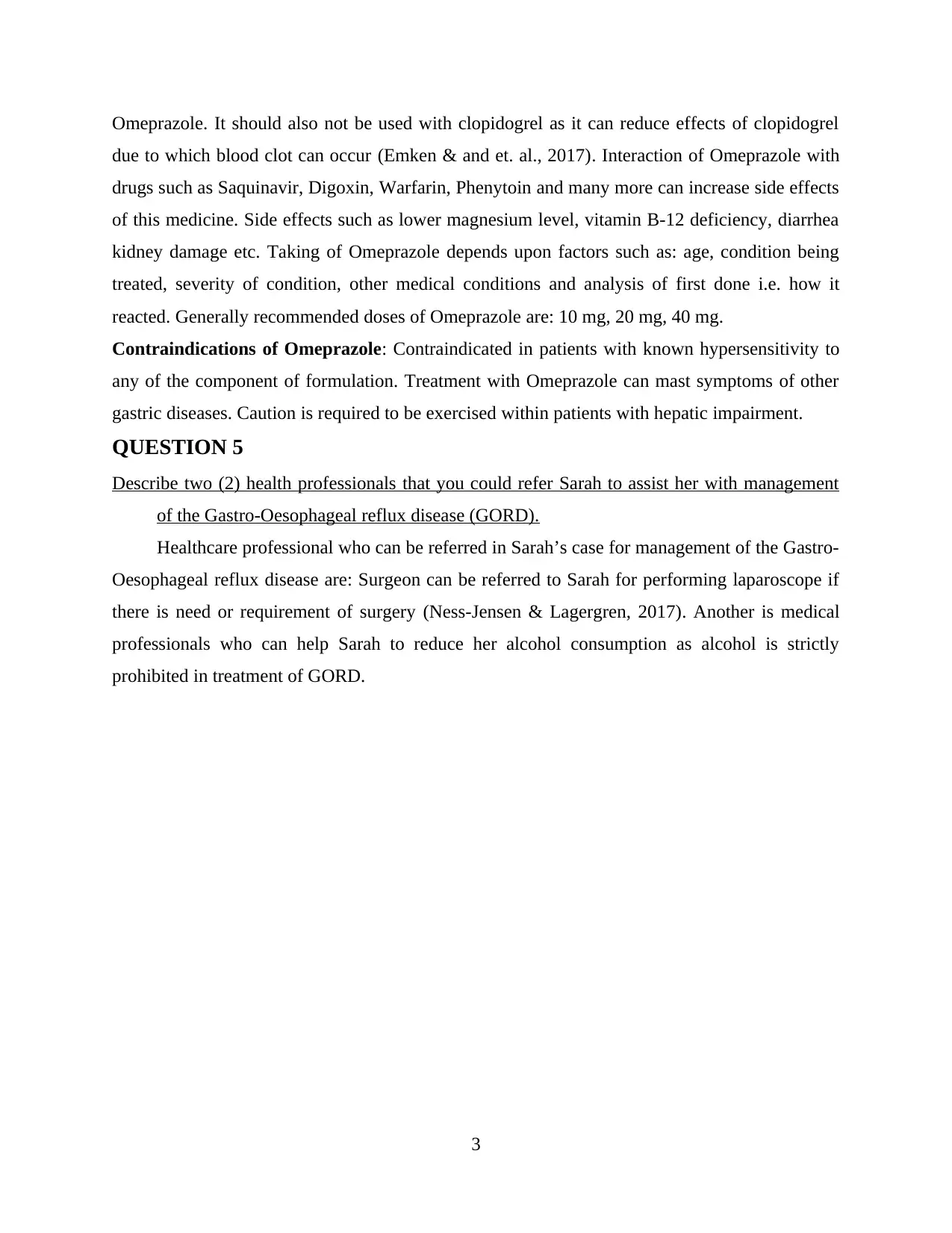
Omeprazole. It should also not be used with clopidogrel as it can reduce effects of clopidogrel
due to which blood clot can occur (Emken & and et. al., 2017). Interaction of Omeprazole with
drugs such as Saquinavir, Digoxin, Warfarin, Phenytoin and many more can increase side effects
of this medicine. Side effects such as lower magnesium level, vitamin B-12 deficiency, diarrhea
kidney damage etc. Taking of Omeprazole depends upon factors such as: age, condition being
treated, severity of condition, other medical conditions and analysis of first done i.e. how it
reacted. Generally recommended doses of Omeprazole are: 10 mg, 20 mg, 40 mg.
Contraindications of Omeprazole: Contraindicated in patients with known hypersensitivity to
any of the component of formulation. Treatment with Omeprazole can mast symptoms of other
gastric diseases. Caution is required to be exercised within patients with hepatic impairment.
QUESTION 5
Describe two (2) health professionals that you could refer Sarah to assist her with management
of the Gastro-Oesophageal reflux disease (GORD).
Healthcare professional who can be referred in Sarah’s case for management of the Gastro-
Oesophageal reflux disease are: Surgeon can be referred to Sarah for performing laparoscope if
there is need or requirement of surgery (Ness-Jensen & Lagergren, 2017). Another is medical
professionals who can help Sarah to reduce her alcohol consumption as alcohol is strictly
prohibited in treatment of GORD.
3
due to which blood clot can occur (Emken & and et. al., 2017). Interaction of Omeprazole with
drugs such as Saquinavir, Digoxin, Warfarin, Phenytoin and many more can increase side effects
of this medicine. Side effects such as lower magnesium level, vitamin B-12 deficiency, diarrhea
kidney damage etc. Taking of Omeprazole depends upon factors such as: age, condition being
treated, severity of condition, other medical conditions and analysis of first done i.e. how it
reacted. Generally recommended doses of Omeprazole are: 10 mg, 20 mg, 40 mg.
Contraindications of Omeprazole: Contraindicated in patients with known hypersensitivity to
any of the component of formulation. Treatment with Omeprazole can mast symptoms of other
gastric diseases. Caution is required to be exercised within patients with hepatic impairment.
QUESTION 5
Describe two (2) health professionals that you could refer Sarah to assist her with management
of the Gastro-Oesophageal reflux disease (GORD).
Healthcare professional who can be referred in Sarah’s case for management of the Gastro-
Oesophageal reflux disease are: Surgeon can be referred to Sarah for performing laparoscope if
there is need or requirement of surgery (Ness-Jensen & Lagergren, 2017). Another is medical
professionals who can help Sarah to reduce her alcohol consumption as alcohol is strictly
prohibited in treatment of GORD.
3
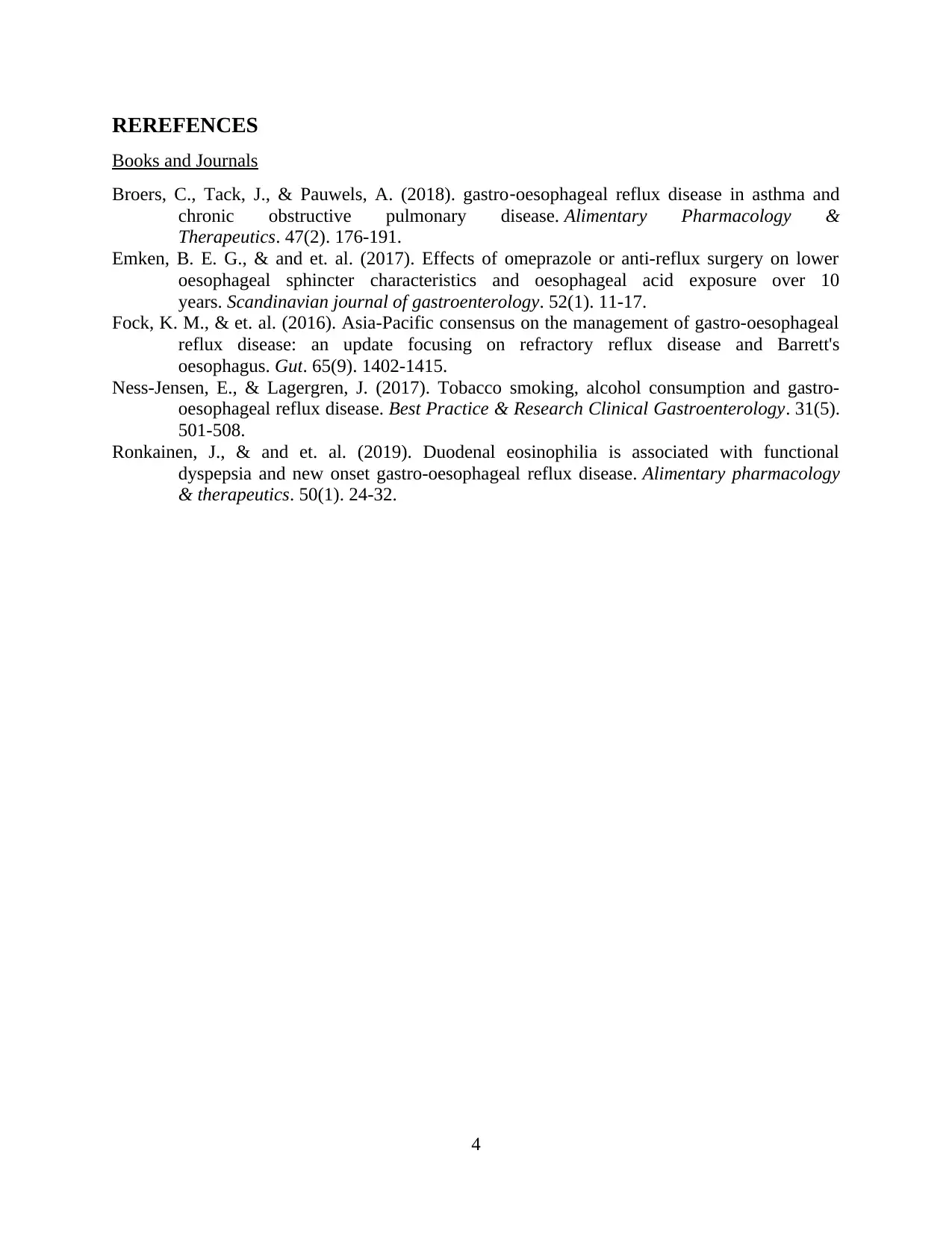
REREFENCES
Books and Journals
Broers, C., Tack, J., & Pauwels, A. (2018). gastro‐oesophageal reflux disease in asthma and
chronic obstructive pulmonary disease. Alimentary Pharmacology &
Therapeutics. 47(2). 176-191.
Emken, B. E. G., & and et. al. (2017). Effects of omeprazole or anti-reflux surgery on lower
oesophageal sphincter characteristics and oesophageal acid exposure over 10
years. Scandinavian journal of gastroenterology. 52(1). 11-17.
Fock, K. M., & et. al. (2016). Asia-Pacific consensus on the management of gastro-oesophageal
reflux disease: an update focusing on refractory reflux disease and Barrett's
oesophagus. Gut. 65(9). 1402-1415.
Ness-Jensen, E., & Lagergren, J. (2017). Tobacco smoking, alcohol consumption and gastro-
oesophageal reflux disease. Best Practice & Research Clinical Gastroenterology. 31(5).
501-508.
Ronkainen, J., & and et. al. (2019). Duodenal eosinophilia is associated with functional
dyspepsia and new onset gastro‐oesophageal reflux disease. Alimentary pharmacology
& therapeutics. 50(1). 24-32.
4
Books and Journals
Broers, C., Tack, J., & Pauwels, A. (2018). gastro‐oesophageal reflux disease in asthma and
chronic obstructive pulmonary disease. Alimentary Pharmacology &
Therapeutics. 47(2). 176-191.
Emken, B. E. G., & and et. al. (2017). Effects of omeprazole or anti-reflux surgery on lower
oesophageal sphincter characteristics and oesophageal acid exposure over 10
years. Scandinavian journal of gastroenterology. 52(1). 11-17.
Fock, K. M., & et. al. (2016). Asia-Pacific consensus on the management of gastro-oesophageal
reflux disease: an update focusing on refractory reflux disease and Barrett's
oesophagus. Gut. 65(9). 1402-1415.
Ness-Jensen, E., & Lagergren, J. (2017). Tobacco smoking, alcohol consumption and gastro-
oesophageal reflux disease. Best Practice & Research Clinical Gastroenterology. 31(5).
501-508.
Ronkainen, J., & and et. al. (2019). Duodenal eosinophilia is associated with functional
dyspepsia and new onset gastro‐oesophageal reflux disease. Alimentary pharmacology
& therapeutics. 50(1). 24-32.
4
⊘ This is a preview!⊘
Do you want full access?
Subscribe today to unlock all pages.

Trusted by 1+ million students worldwide
1 out of 6
Related Documents
Your All-in-One AI-Powered Toolkit for Academic Success.
+13062052269
info@desklib.com
Available 24*7 on WhatsApp / Email
![[object Object]](/_next/static/media/star-bottom.7253800d.svg)
Unlock your academic potential
Copyright © 2020–2025 A2Z Services. All Rights Reserved. Developed and managed by ZUCOL.





